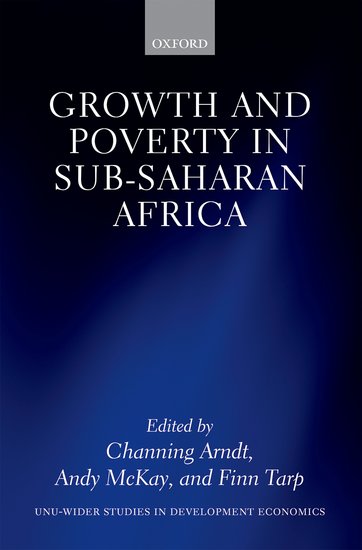News
New open access book - Growth and Poverty in Sub-Saharan Africa
On 14 April 2016 Oxford University Press (OUP) published UNU-WIDER’s first open access book, Growth and Poverty in Sub-Saharan Africa, edited by Channing Arndt, Andy McKay, and Finn Tarp. While much research is freely available on the web, a great deal also sits behind paywalls. Or is accessible only if you are a member of a university library that subscribes to the journal and purchases the books you want. Access in the global South can be especially limited—when library resources are meager and bandwidth slow. UNU-WIDER is committed to negotiating with publishers to offer more of its journal papers and books on open access. So you, our readers, can freely access more of our publications online. This doesn’t come cheap, but we think the benefits more than outweigh the financial costs. Since 2004 all UNU-WIDER journal articles have been open access but this is the first volume of the OUP series WIDER Studies in Development Economics to be made available in this way. We plan to work with OUP in the future to bring even more of our publications under the open access banner.
 The book—resulting from UNU-WIDER’s project on ’Reconciling Africa’s growth, poverty and inequality trends: growth and poverty’—provides a comprehensive re-examination of Africa’s growth, poverty and inequality trends. While the economic growth renaissance in sub-Saharan Africa is widely recognized, much less is known about progress in living conditions. This book comprehensively evaluates trends in living conditions in 16 major sub-Saharan African countries, corresponding to nearly 75% of the total population.
The book—resulting from UNU-WIDER’s project on ’Reconciling Africa’s growth, poverty and inequality trends: growth and poverty’—provides a comprehensive re-examination of Africa’s growth, poverty and inequality trends. While the economic growth renaissance in sub-Saharan Africa is widely recognized, much less is known about progress in living conditions. This book comprehensively evaluates trends in living conditions in 16 major sub-Saharan African countries, corresponding to nearly 75% of the total population.
A striking diversity of experience emerges. While monetary indicators improved in many countries, others are yet to succeed in channeling the benefits of economic growth into the pockets of the poor. Some countries experienced little economic growth and saw little material progress for the poor. At the same time, the large majority of countries have made impressive progress in key non-monetary indicators of wellbeing.
Overall, the African growth renaissance earns two cheers, but not three. While gains in macroeconomic and political stability are real, they are also fragile. Growth on a per capita basis is much better than in the 1980s and 1990s, yet not rapid compared with other developing regions. Importantly from a pan-African perspective, key economies—particularly Kenya, Nigeria, and South Africa—are not among the better performers.
Looking forward, realistic expectations are required. The development process is, almost always, a long, hard slog. Nevertheless, real and durable factors appear to be at play in Africa with positive implications for growth and poverty reduction in future.
The book is freely available to download on the OUP website, simply hover over the open access logo to get the PDF. For more on this topic visit the project page, check out our blog, and follow us on Twitter @UNUWIDER.
 Join the network
Join the network